Summer of Adventure: Rock Climbing
Welcome to the final article in our Summer of Adventure series! Over the last two months, we’ve spoken with experts in sailing and SCUBA diving to learn the best ways to get started in those sports and add some of that Bond style adventure to our lives. In this post we’ll focus on one of my favorite outdoor activities: rock climbing!
Heroes on the rocks
There was 10 year period between the early 1990s and the early 2000s when rock climbing was the sport for Hollywood action movies. Cliffhanger, Mission Impossible II and Vertical Limit (directed by Martin Campbell of Goldeneye and Casino Royale fame) were just a few of the more popular films that featured our favorite heroes out on the cliffs.

But, Hollywood being Hollywood, the climbing in the movies had to look as exciting and dangerous as possible. Equipment fails, no one seems to use a rope and plenty of people fall to their deaths. And it wasn’t a “climbing movie” unless there was at least one shot of the hero hanging from the rock by one hand!
Since the Bond films are known for their over-the-top action scenes, it’s somewhat ironic that 1981’s For Your Eyes Only contains one of more realistic depictions of climbing in the movies. 007’s ascent of Metéora shows some classic climbing moves (even Roger Moore does a decent job in the close-ups). And, as a bonus, it features Rick Sylvester performing an epic Bond stunt: a 100 foot fall that still makes my palms sweat a little!

As a former climber myself, I feel confident saying that rock climbing in real life is almost never like what we see in the movies. So how hard is it for us mere mortals to get started in the sport? What training and equipment do we need? And how dangerous is climbing? We’ll attempt to answer those questions (and more) in this article. Let’s get started!
Our Expert
To learn what it really takes to get started in the sport of rock climbing, we spoke with Keith Moon, the manager of the Eastern Mountain Sports Climbing School in North Conway, New Hampshire.
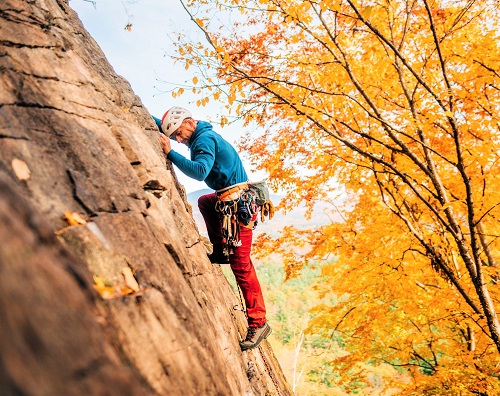
Keith started climbing when he was just 7 years old and now has 25 years of experience out on the cliffs and mountains. He’s worked as a professional guide for the last 15 years, earning his certification as an American Mountain Guides Association Alpine Guide and Rock Instructor and Course Instructor with The American Institute for Avalanche Research and Education along the way. The man knows climbing. And he knows the best ways to safely and enjoyably introduce newcomers to the sport!
Learning to Rock Climb: Our Interview with Keith Moon
Let’s start with the fun question: how different is climbing in real life compared to what we see in the movies?
Some of the movies do depict some of the elements of climbing pretty well. The classic one is Tom Cruise at the start of Mission Impossible II, when he’s out there climbing without a rope. That’s called free soloing and there are people that really do that. And most of his moves actually look pretty realistic, except for that ridiculous jump.
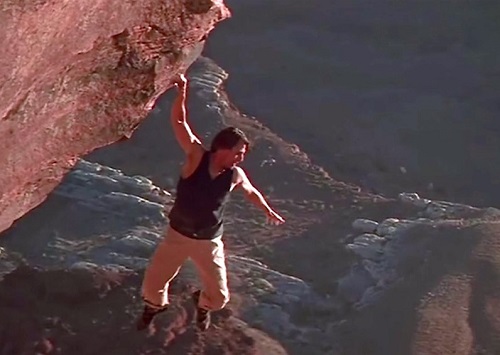
But the movies almost always try and make climbing look much more dramatic than it is in real life. The characters are moving faster or doing crazy moves. So when people come to us to go climbing for the first time, they’re maybe expecting this over-the-top experience that’s going to be really scary and a non-stop struggle. Real life climbing is much slower and focuses more on good technique. Once beginners understand that, they start to relax.
In your experience, how easy is it for people to get started in rock climbing?
I’ll start with the psychological aspect. I think the first thing people need to do is let go of their preconceptions. If all you’ve seen of climbing has come from movies, you’re maybe thinking it’s incredibly dangerous and if you fall you’ll die. Or that you have to be some kind of superhero to climb. And that’s just not the reality of the sport.
One good thing is there’s now more access to the climbing than ever before. And not just outside. Almost every city has one or two indoor climbing gyms where people can try it out. So giving it a try doesn’t have to be difficult or expensive. And that’s certainly helped people gain a better understanding of what the sport is really about.

As far as physical conditioning goes, again I think a lot of the challenges are more psychological. Good climbing is really about proper technique, and you use your feet much more than most beginners expect. So if you’re holding off trying the sport because you can’t do a pull up, I wouldn’t let that stop you.
And because climbing uses a rating system, you can also choose how difficult you want the challenge to be, correct?
Right, exactly. That’s one of the things that makes climbing a lifelong activity. When you go out to a cliff or to a gym, each route has a rating that tells you how hard it will be. So you can pick and choose how hard you want to climb, how much you want to challenge yourself, based on your skill level or physical ability or experience. Or even just how you’re feeling that day.
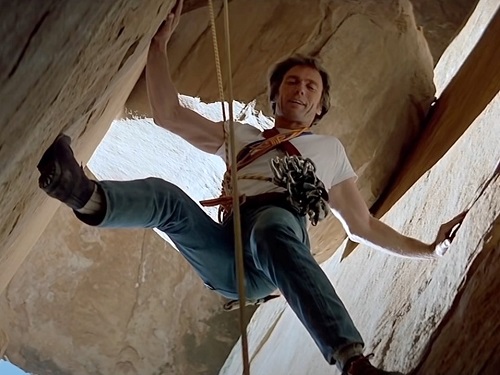
Can you tell us a little about how the rating system works?
All terrain is broken down along a scale. Something like a trail hike in the forest would be a Class 2. Rock climbing, when you have to use your hands and feet to ascend a rock face and you’re using a rope and harness for safety, starts at Class 5. And that Class 5 is broken down again into sub-classes starting at 5.0. So a moderately easy climb would be something rated 5.4 or 5.5. And right now the hardest climbing routes out there are in the 5.15 range.
The rating system works as a good guide for the difficulty of a climb, but there are other factors you need to consider. Who put up that route? If it was some guy who’s 6’1” and you’re only 5’8” then you may find it more difficult because of your shorter reach. When was the route established? Our sense of what’s “difficult” has changed over time. So a 5.8 or 5.9 from 50 or 60 years ago might be more challenging than a 5.9 someone puts up today.
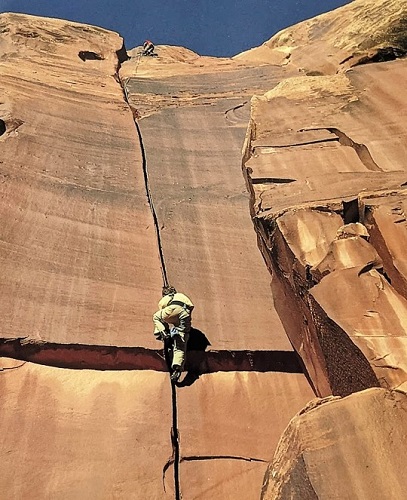
But getting to know the area where you’re climbing and its history is definitely part of the fun!
So when you take out a group of beginners on a course, what level are you starting at?
Something interesting that’s been happening more recently with people who want to try outdoor climbing for the first time is that many of them already have some indoor climbing gym experience. So as “beginners” they often have some technique and a good idea of how to move.
But of course the outdoor experience is very different than the indoor. For example, the holds on a route outdoors aren’t color coded the way they are in a gym. You need to search around on the rock to find where you can place your feet and hands and it won’t always be obvious.
And many of the outdoor routes are going to be much longer than you’d find in a gym. So you may feel great climbing a 30 foot 5.8 route on an indoor wall. But it can be much more challenging when you’re facing 100+ feet of 5.8 climbing on a cliff. Not only because of the length of the climb. There’s also the psychology of the dealing with the height. When you get up there on those longer routes, you really start to feel the exposure!
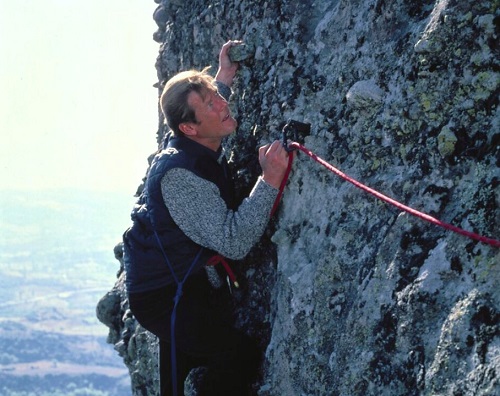
So for the typical beginner course we’ll start with something easier in the 5.5 range. Maybe they can climb harder indoors. But we want to make sure they get comfortable with the environment.
And what topics do you typically cover in a beginner’s course?
At EMS, we offer a one-day introductory class that’s open to anyone that’s genuinely interested in learning to climb. On that day, we cover some basic information: how to put your harness on correctly, how to tie into the rope and belaying technique. But the goal is really to get people outside and let them experience what climbing is like. So we climb a lot!
I think that brings us to an important question many people are asking: how safe is climbing?
That’s a pretty complex question. I think it’s easiest to look at it two ways.
When most people are starting to climb outdoors, they’re probably going to use a top rope set-up. That’s when the climber is tied into one end of the rope, then the rope goes up through anchors at the top of the cliff and then back down to the belayer. The belayer is the person who is pulling in the rope as you climb up and stops the rope when you fall. It kind of works like a pulley system. So if you do fall, the distance is going to be minimal, basically just the rope stretch, because the belayer is keeping the rope tight.
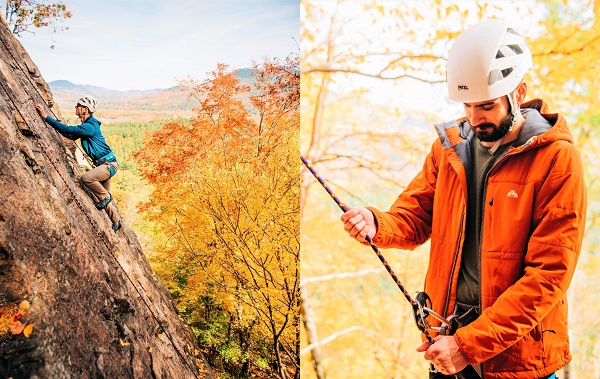
But that also brings up a very important point: climbing is a partnership. When you’re belaying someone, you literally have that person’s life in your hands. That’s a huge responsibility and you need to stay focused and communicate every second your partner is climbing.
Almost every accident in climbing happens because of human error, almost never because of equipment failure. Which is another myth you sometimes see in the movies: harness buckles breaking, ropes snapping or carabiners bending open. If you maintain your equipment properly, that will never happen. Ultimately, your well-being and safety is going to depend on your training and the training of the people you’re climbing with.
And as an expert, what questions would you ask a climbing school to make sure you’re getting the best training possible?
The number one thing to look at when choosing a service is: what is the guide’s professional training. The main training body in the U.S. is the American Mountain Guides Association (AMGA). All our guides at EMS are accredited through the AMGA, which means they not only have the technical climbing expertise, they’ve also been trained in wilderness medicine, client management and “leave no trace” practices. We’re one of only 30 schools in the country with that status.
So if your guide or instructor has certification from the AMGA, you can be pretty confident in his or her skill level and that they’re going to use and teach you the best practices during the course to make the climbing as safe as possible.
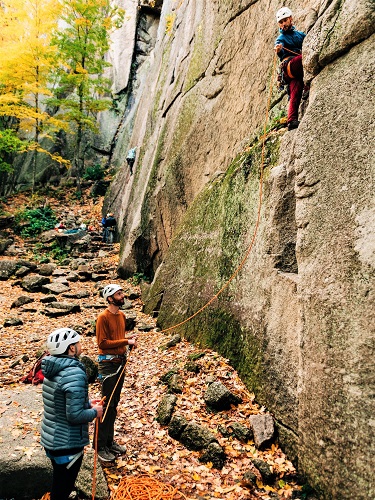
And educating beginners on those best practices is very important. As I said, climbing is about partnerships. So if you’ve seen those best practices in action throughout your course, you’re going to have a good idea what to look for when you’re choosing a partner for you own climbing trips.
What equipment do I need to get started climbing?
Start with your harness, your shoes, a couple of locking carabiners and your belay device. All together, you could get that set up for less than $200. And then if you plan on climbing outside often, I’d definitely get a helmet and then invest in a rope, which will cost between $150 and $300. It’s really not that expensive to get into the sport. And the nice thing is that the individual pieces of climbing equipment don’t cost very much. So you can easily add new equipment as you advance and want to try more technical climbing.
And our last question: what keeps bringing you back to climbing?
The freedom. Not just in the sense of being outside (although that’s a big part of it). It’s more the feeling that I get to decide what I want to do. There’s no coach that determines if you’re going to play in the game. It’s all up to me, and if I want to climb this route or on that cliff I can go do that. And with that freedom comes a sense of your own capabilities. Because you need to be self-reliant, you need to know if you’re physically and mentally prepared to face some of those challenges.

It’s the totality of the experience, the environment combined with the physical and psychological aspects, that keeps bringing me back. And at this point I don’t think I could stop climbing, even if I wanted to!
A big THANK YOU to Keith and the crew at Eastern Mountain Sports Climbing School for sharing their time and expertise with us! If you’re interested in learning to climb, EMS offers a one day Rock Climbing 101 course for $160.00 per person in various locations in the North Eastern U.S. To get a sense of what real climbing is all about, you can also follow EMS on Instagram. And to find other reputable climbing schools throughout the U.S., check out the American Mountain Guides Association’s list of accredited businesses here.